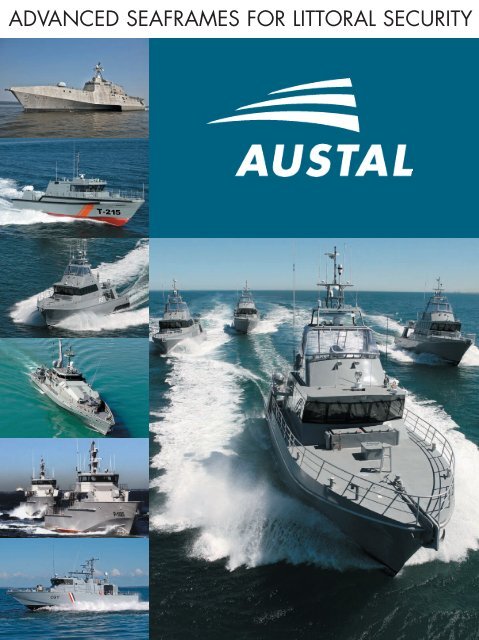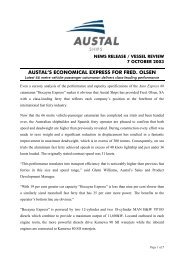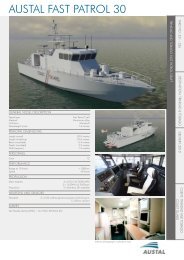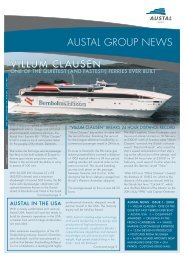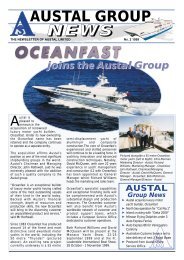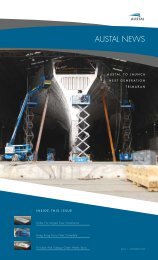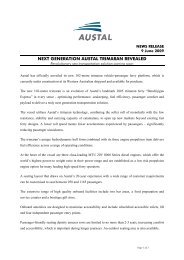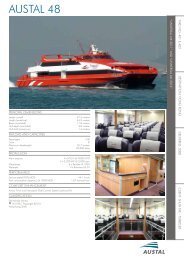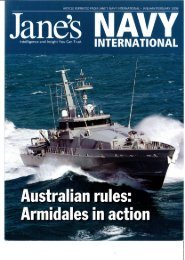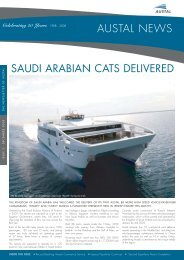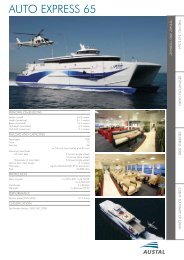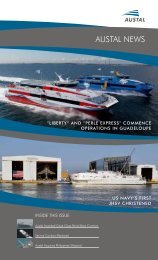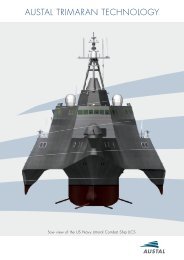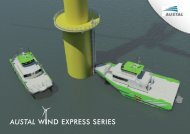ADVANCED SEAFRAMES FOR LITTORAL SECURITY - Austal Ships
ADVANCED SEAFRAMES FOR LITTORAL SECURITY - Austal Ships
ADVANCED SEAFRAMES FOR LITTORAL SECURITY - Austal Ships
You also want an ePaper? Increase the reach of your titles
YUMPU automatically turns print PDFs into web optimized ePapers that Google loves.
<strong>ADVANCED</strong> <strong>SEAFRAMES</strong> <strong>FOR</strong> <strong>LITTORAL</strong> <strong>SECURITY</strong>
USS Independence is the<br />
first of a new generation<br />
of aluminium trimaran<br />
Littoral Combat Ship
THINKING<br />
WITHOUT<br />
BARRIERS<br />
<strong>Austal</strong> is re-writing the rule book in the<br />
design and construction of vessels for<br />
military and security applications<br />
Navies have often been regarded as among the most<br />
conservative of customers, inherently wary of radical<br />
innovation in naval architecture and ship design. This<br />
stereotype is not without foundation or reason: first, the<br />
marine environment is harsh and unforgiving, and every major<br />
warship represents a significant capital investment designed<br />
to have a service lifetime spanning between two and three<br />
decades; second, navies have by and large pursued an incremental<br />
approach so as not to inadvertently<br />
cast away the hard-won<br />
lessons of operational experience<br />
accrued through both peacetime<br />
and conflict.<br />
Yet paradoxically, this slow and<br />
evolutionary natural order of warship<br />
development has been punctuated<br />
at key junctures by the bold adoption<br />
of innovative ship design, marine<br />
engineering and/or system architecture<br />
approaches that depart radically<br />
<strong>Austal</strong>’s Henderson facility<br />
from conventional wisdom. These<br />
paradigm shifts generally occur<br />
when technological breakthroughs and operational imperatives<br />
coalesce to create the conditions for fresh thinking,<br />
novel concepts and new enterprise solutions.<br />
So it is perhaps no coincidence that the emergence of<br />
Australia-based aluminium shipbuilder <strong>Austal</strong> as a growing<br />
force in the defence market has come at a time when many<br />
navies are radically reappraising the capabilities and characteristics<br />
required of their future fleets. No where is that more<br />
apparent than in the United States, where the huge potential<br />
of advanced aluminium seaframes is being very firmly<br />
grasped for both littoral warfighting and intra-theatre logistics<br />
missions.<br />
From humble origins in 1988, <strong>Austal</strong> has set out to differentiate<br />
itself from ‘industrial-age’ shipbuilders, and in doing so<br />
sought to challenge the conventions and break the moulds so<br />
long associated with traditional practice. This is evidenced by<br />
its advocacy of marine aluminium alloy as a material of<br />
choice; a willingness to embrace the hydrodynamic, powering<br />
and layout benefits afforded by advanced high-speed multihull<br />
forms; an assembly-line production philosophy that owes<br />
more to modern aerostructures manufacture than its does to<br />
classic shipbuilding practice; and a customer-focused delivery<br />
culture that endures well beyond vessel acceptance.<br />
It was these tenets that initially brought the company success<br />
in the commercial arena. As John Rothwell, <strong>Austal</strong>’s<br />
founder and chairman, reflects: “Our original vision was to<br />
build medium-size fast catamaran passenger ferries, with a<br />
firm focus on the Asian market. We honed our skills in this<br />
sector, putting particular emphasis on production facilities<br />
and manufacture efficiencies to enable us to offer tailored<br />
designs at affordable prices.”<br />
These same principles were later translated to meet the<br />
needs of customers in the defence and security sector. ”The<br />
company saw a need in the late 1990s to diversify the product<br />
portfolio as the ferry market softened,” says Rothwell,<br />
“We identified opportunities in the defence and paramilitary<br />
sector, and in 1998 achieved a first success with an order for<br />
eight patrol boats for the Australian Customs Service.”<br />
Fast forward to the present day. From its small beginnings,<br />
<strong>Austal</strong> has progressively grown through a combination of<br />
selected acquisitions, advanced design development, leverage<br />
from the commercial sector, far-sighted investment in<br />
new plant, process and information technology, and a strategy<br />
of product and market diversification .<br />
As a result, the company’s production resource now<br />
encompasses three facilities located close to its headquarters<br />
in Henderson, Western Australia, a vessel production/refit<br />
yard in Tasmania specialising in vessels up to 60 metres, and<br />
<strong>Austal</strong> USA’s new state-of-the-art ship construction and<br />
assembly operation in Mobile, Alabama. Equally important, it<br />
has built up a strong multi-disciplinary<br />
team of almost 200 naval architects,<br />
engineers and designers inhouse,<br />
giving the company a complete<br />
capability for the design of<br />
advanced aluminium vessels while at<br />
the same time ensuring hands-on<br />
construction oversight, and reduced<br />
design and construction integration<br />
risk.<br />
The past 14 years have seen the<br />
company continue to build on its<br />
early successes. On the commercial<br />
side, it has become a market leader<br />
in the design and construction of a new genre of fast multihull<br />
ROPAX ferries that have revolutionised the economics of<br />
point-to-point sea freighting. This has included the pioneering<br />
127 m vehicle/passenger ferry Benchijigua Express, the<br />
largest trimaran vessel in commercial service anywhere in the<br />
world.<br />
In parallel, <strong>Austal</strong> has carved a niche in the defence sector.<br />
As well as establishing itself as a leading supplier of flexible<br />
but affordable fast patrol craft to the Royal Australian Navy<br />
and other local and international government agencies, it has<br />
more recently achieved notable success in applying its innovative<br />
aluminium multi-hull design and construction expertise<br />
to meet the needs of the US military.<br />
According to Rothwell, it was around the turn of the century<br />
that the US armed services first began to appreciate the<br />
potential of commercial high speed vessel technology for military<br />
purpose. “There was an awakening of interest in how<br />
fast ships could serve as intra-theatre sealift assets, and<br />
shortly afterwards, the US Marine Corps chartered the 101 m<br />
WestPac Express, at that stage the largest of <strong>Austal</strong>’s Auto<br />
Express series of vehicle-passenger ferries, to serve as a high<br />
ADVERTISING SUPPLEMENT<br />
3
The Royal Australian Navy operates 14 <strong>Austal</strong>built<br />
Armidale class patrol craft<br />
speed theatre logistics vessel supporting the Third Marine<br />
Expeditionary Force in Okinawa.”<br />
Encouraged by this burgeoning interest in theatre sealift,<br />
later to become a joint service Program of Record, <strong>Austal</strong><br />
took a strategic decision to establish a manufacturing footprint<br />
in the United States. This was achieved through a joint<br />
venture, established in 1999, which saw a brand new facility<br />
built on Pinto Island, Mobile, initially to build commercial craft.<br />
<strong>Austal</strong> USA went on to take full ownership in 2006.<br />
While the US services began to develop a requirement for a<br />
new class of Joint High Speed Vessel (JHSV), another US<br />
opportunity presented itself in the shape of the Littoral<br />
Combat Ship (LCS) programme. “We were able to bring the<br />
US Navy across to visit Benchijigua Express and convince<br />
them of the advantages offered by a trimaran,” says Rothwell.<br />
“Our design was subsequently downselected as one of two<br />
LCS seaframes to go into build.”<br />
Further success followed in 2008 when <strong>Austal</strong> USA, by now<br />
fully accredited as a secure site, was selected to deliver the<br />
JHSV programme to meet the combined needs of the US<br />
Army and US Navy. An initial requirement exists to build 10<br />
vessels using a commercially-derived catamaran design, but<br />
as Rothwell points out, the final number “could be more than<br />
double this figure.”<br />
So what are the factors that have shaped this success For<br />
one thing, <strong>Austal</strong> has honed a design resource unrivalled in its<br />
understanding of high performance aluminium ships, offering<br />
a wealth of expertise and a proven ability to engineer customised<br />
solutions to meet specific user requirements. In parallel,<br />
it has maintained a vibrant research and development<br />
programme that has matured innovation in hydrodynamics,<br />
structures, power and propulsion and ride control.<br />
Next, it has succeeded in migrating commercial off-theshelf<br />
(COTS) design solutions into the military environment by<br />
methodically engineering proven aluminium fast ship technologies<br />
into high performance designs – without compromise<br />
to operability, safety or survivability. This is borne out by<br />
a track record of 69 vessels delivered, in build or on order, to<br />
12 armed forces and law enforcement agencies worldwide.<br />
The company has also invested in the in-house development<br />
of key system technologies interwoven into its<br />
advanced high speed multi-hull designs. For example,<br />
<strong>Austal</strong>’s MarineLink ship monitoring and control network<br />
allows for comprehensive real-time monitoring and management<br />
of machinery and systems ship-wide from the bridge. In<br />
addition, MarineLink produces trend information to support<br />
vessel operation and platform diagnostics.<br />
Similarly, <strong>Austal</strong> has continued to cultivate its own expertise<br />
in ride control systems. This capability includes sophisticated<br />
computer-based modeling tools to predict and evaluate seakeeping<br />
performance, and the development, manufacture<br />
and integration of software-controlled motion control systems<br />
to reduce ship motions at speed and in higher sea states.<br />
Production efficiency is another major contributor to<br />
<strong>Austal</strong>’s performance and competitiveness. The company’s<br />
manufacturing facilities have been optimized to streamline<br />
workflow and maximise productivity, with a particular focus<br />
on large scale modular pre-outfit.<br />
Offloading from WestPac Express<br />
4<br />
ADVERTISING SUPPLEMENT
Intrinsic to this continuing drive for efficiency is the<br />
Advanced Ship Building (ASB) programme, a continuous<br />
improvement and change management initiative woven into<br />
the fabric of <strong>Austal</strong>’s business. ASB is all about improving efficiency<br />
and increasing output quality, achieved through the<br />
adoption of new operating processes and manufacturing<br />
techniques, integrated project planning, coordinated logistics,<br />
greater accuracy in piece part manufacture, and rigorous<br />
configuration control.<br />
Further benefits are anticipated from the roll-out of a waste<br />
elimination programme based on ‘lean’ manufacturing principles.<br />
This is already delivering significant gains in productivity<br />
alongside improvements in quality and shopfloor safety.<br />
The other special ingredient, Rothwell believes, is a culture<br />
and mindset that challenges conformity and puts the customer<br />
first. “There is very much a ‘can do’ approach,” he says,<br />
adding “Our business has been all about giving clients,<br />
whether commercial or military, solutions that were simply<br />
unattainable using traditional approaches. We’ve done that<br />
through innovative engineering and world-class manufacturing.<br />
“<strong>Austal</strong> is leading in an industry where no one else has<br />
been, so we can’t copy. We’re thinking without barriers.”<br />
Looking to the future, the corporate business plan anticipates<br />
a continued intake of both commercial and defence<br />
work, with the latter expected to account for slightly more<br />
than half of group turnover in the longer term. <strong>Austal</strong> USA will<br />
focus its operations on the military market, with high hopes<br />
that LCS and JHSV production will be buoyed by international<br />
orders through US government Foreign Military Sales.<br />
Outside of the United States, <strong>Austal</strong> is examining options to<br />
establish a specialist military production facility operating<br />
separate to its existing commercial build facilities. This would<br />
harness the production efficiencies of the company’s aluminium<br />
shipbuilding operation, while at the same time providing<br />
a secure site environment aligned to the more complex<br />
integration, certification and security requirements of naval<br />
customers.<br />
What’s more, alongside its established range of patrol and<br />
auxiliary boat designs, <strong>Austal</strong> is introducing a new Multi-Role<br />
Vessel concept that combines the efficiencies and layout<br />
advantages of the trimaran hullform with a system of modular<br />
mission payloads. The result is an agile yet affordable littoral<br />
combatant geared to the needs of the 21st century navy.<br />
Another line of development is through-life service support.<br />
<strong>Austal</strong> has taken responsibility as the ship manager for<br />
WestPac Express, including planned maintenance management,<br />
and is also providing support to the Royal Australian<br />
Navy’s Armidale class from an operation in Darwin operation.<br />
And its five-year support package for new patrol boats built<br />
for Trinidad and Tobago is likely to be a portend for things to<br />
come.<br />
There is also an acknowledgement that <strong>Austal</strong> should adapt<br />
to a global marketplace where customers increasingly aspire<br />
to in-country manufacture. Rothwell points out that the company<br />
“is open to exploring options for technology transfer,<br />
whether through the direct licensing of designs or the creation<br />
of joint ventures”.<br />
<strong>Austal</strong> remains a young company, celebrating the 21st<br />
anniversary of its formation in 2009, yet its track record of<br />
success, first in the commercial market and now repeated in<br />
the defence sector, suggests it has more than come of age. In<br />
a short time, it has effectively torn up the conventions of military<br />
shipbuilding by applying commercial business processes<br />
and COTS technology solutions carefully tailored to meet the<br />
capability requirements of defence customers. Above all,<br />
<strong>Austal</strong> has shown that things can be done differently.<br />
Extensive in-service experience<br />
with aluminium hulls,<br />
together with a continuing<br />
programme of research, development<br />
and technology<br />
demonstration, has given<br />
<strong>Austal</strong> the confidence to argue<br />
a persuasive case for using<br />
aluminium material in naval<br />
hull structures. Indeed, as misconceptions<br />
and prejudices<br />
are overcome, an increasing<br />
number of navies have recognised<br />
the benefits of reduced<br />
structural weight, better fuel<br />
economy and enhanced corrosion<br />
resistance that aluminium<br />
confers.<br />
Aluminium is approximately<br />
one third the weight of steel,<br />
offering a far lower lightship<br />
displacement and therefore<br />
increasing speed and fuel efficiency<br />
without sacrificing<br />
structural strength. It is also<br />
an extremely robust material<br />
for marine operation; in the<br />
case of a high shock loading,<br />
the high ductility of aluminium<br />
ensures that significant panel<br />
deformation can be tolerated<br />
before structural failure.<br />
The corrosion resistance of<br />
marine grade aluminium alloys<br />
ensures that protective coatings<br />
are not required on all<br />
hull surfaces. A protective aluminium<br />
oxide layer that forms<br />
on the material surface<br />
ensures that bilges, tanks,<br />
voids and other internal<br />
spaces do not require the level<br />
of maintenance, and coating<br />
that steel hulls do<br />
Aluminium and steel are<br />
alike in that both materials are<br />
non-combustible and do not<br />
burn. The key behavioural difference<br />
is that aluminium<br />
alloys lose strength at a lower<br />
temperature than steel (degradation<br />
starting at temperatures<br />
between 150 and 180<br />
degrees C).<br />
<strong>Austal</strong> recognises that aluminium’s<br />
increased susceptibility<br />
to fire damage demands<br />
increased structural fire protection<br />
in those areas of fire<br />
risk, this being delivered<br />
through a ceramic fibre wool<br />
materiel and the installation of<br />
active fire suppression systems.<br />
However, the substantial<br />
difference in structural weight<br />
more than offsets the weight<br />
of additional fire protection<br />
measures.<br />
The company also points out<br />
that aluminium conducts heat<br />
more effectively than mild<br />
steel. This thermal conductivity<br />
assists in the dissipation of<br />
heat during a fire and allows<br />
rapid boundary cooling of<br />
exposed structures.<br />
<strong>Austal</strong>’s highly skilled workforce delivers<br />
outstanding efficiency and quality<br />
ADVERTISING SUPPLEMENT<br />
5
Matching finite budgets to an ever-widening range of<br />
maritime security and warfare enabling tasks is a<br />
problem that continues to challenge navies worldwide.<br />
Many forces are discovering that the one-to-one<br />
replacement of existing minor war vessel types – patrol vessels,<br />
mine countermeasures craft and survey ships – is both<br />
unaffordable (in terms of acquisition cost) and undesirable<br />
(given the training, logistics, organisation and manning overheads<br />
that aggregate through-life from a series of unique,<br />
niche and largely bespoke platforms).<br />
As a consequence, there is significant evidence of a shift in<br />
thinking towards the concept of a modular and reconfigurable<br />
minor warship design that confers an ability to be reconfigured<br />
to satisfy a range of different roles according to<br />
the specific mission payload embarked. Reconfigurability is<br />
increasingly attractive to navies that want to be able to<br />
adjust the balance of roles and missions performed by<br />
individual units warships in a flotilla as tasking priorities<br />
evolve over time. This offers improved role (versus hull number)<br />
flexibility through life.<br />
This trend is reflected by a number of emergent platform/capability<br />
requirements. For example, Australia’s<br />
Project SEA 1180, as a core component of the Royal<br />
Australian Navy’s Force 2030 vision, plans to replace legacy<br />
patrol boat, mine countermeasures (MCM), hydrographic<br />
and oceanographic forces with a single modular multirole<br />
class of Offshore Combatant Vessels.<br />
In articulating this approach, the Defence Capability Plan<br />
2009 describes the rationalisation of the small ship fleet as<br />
“an opportunity to leverage<br />
the advantages of platform<br />
and systems commonality as<br />
far as it can be implemented<br />
to fulfil a range of maritime<br />
missions”. It adds that its<br />
planned approach “is<br />
intended to exploit the advantages<br />
of using either the same<br />
vessel or a family of vessels to<br />
conduct offshore security,<br />
mine countermeasure and<br />
hydrographic roles,” noting<br />
that, where possible, “this<br />
vessel or family of vessels will<br />
employ modular concepts that<br />
enable each to be employed<br />
in multiple roles to meet the<br />
needs of particular operations<br />
or strategic circumstances”.<br />
<strong>Austal</strong> has already started thinking along similar lines.<br />
Drawing on its in-house design expertise, together with<br />
feedback garnered from the RAN and a host of other international<br />
navies, it has produced an innovative Multi Role<br />
Vessel (MRV) design that succeeds in melding the powering,<br />
seakeeping and layout advantages endowed by an aluminum<br />
trimaran seaframe with the adaptability afforded by a<br />
modular payload system. The result is a supremely agile and<br />
cost effective open architecture platform that transcends traditional<br />
ship typologies to deliver superior operational flexibility.<br />
Having already brought large high-speed trimaran technology<br />
into the military marketplace in the shape of the LCS,<br />
<strong>Austal</strong> has continued to evolve and finesse the basic design<br />
in order to further optimise performance, ride control, fuel<br />
VERSATILITY<br />
WITHOUT<br />
COMPROMISE<br />
<strong>Austal</strong>’s Multi Role Vessel offers a new<br />
and innovative approach to meeting a<br />
raft of maritime security needs<br />
efficiency and payload. These improvements are embodied<br />
in the next-generation AutoExpress 102 vehicle/passenger<br />
ferry, construction of which completes at the company’s<br />
Henderson yard in early 2010.<br />
The MRV has been designed to capitalise on this pedigree,<br />
providing users with a versatile yet cost effective littoral<br />
seaframe that exploits the inherent advantages of the trimaran<br />
hullform to offer significant advantages over a similarsize<br />
monohull. These include<br />
improved hydrodynamic performance<br />
and greater propulsion<br />
efficiency, increased<br />
internal volume for a flexible<br />
mission/logistics deck, and a<br />
large and optimally sited flight<br />
deck and hangar for helicopter<br />
and/or unmanned air vehicle<br />
operations and support.<br />
<strong>Austal</strong>’s concept combines<br />
these features with a core<br />
combat system -- scaled for<br />
situational awareness and<br />
self-defence – and a ship<br />
service infrastructure that<br />
supports interfaces to a wide<br />
Aft view of the MRV<br />
range of mission payloads<br />
suited to specific naval, maritime<br />
security, theatre logistics,<br />
law enforcement, and humanitarian roles.<br />
The result is an 80 m platform that seeks to redefine the<br />
term ‘multi-mission’ by offering the prospect of true ‘plug<br />
and play’ operation. This in turn offers end users a highly<br />
adaptable asset that can be rapidly reconfigured to deliver<br />
capability across the full spectrum of operations.<br />
A stand-out feature of the design is the mission bay area<br />
that provides a large storage and/or working area. Payloads<br />
can be moved internally by means of a gantry crane, or<br />
moved out to a V-notch in the transom for launch.<br />
Vehicular access is via an aft stern ramp, while an aft crane<br />
allows for cargo handling and the launch and recovery of<br />
small craft and unmanned surface vehicles. <strong>Austal</strong> is continuing<br />
to investigate novel motion-compensated capture<br />
mechanisms that enable recovery operations to be safely<br />
6<br />
ADVERTISING SUPPLEMENT
The MRV has been specifically designed to<br />
offer maximum versatility in service<br />
and efficiently performed in higher sea states.<br />
The hangar and flight deck are sized for an MRH-90 type<br />
helicopter. The inherent stability of the trimaran form,<br />
together with the positioning of the flight deck nearer to the<br />
center of pitch, significantly reduces motions so as to<br />
expand helicopter operating limits in rough weather.<br />
<strong>Austal</strong> believes the MRV offers an ideal platform from which<br />
to perform EEZ surveillance and maritime security operations,<br />
championing both the efficiency and seakindliness of<br />
the MRV seaframe. While the design is capable of sprint<br />
speeds approaching 30 kt, most operations are likely to be<br />
undertaken at an economical cruise speed between 12 kt<br />
and 15 kt, a powering regime where the hydrodynamic efficiencies<br />
of the trimaran form yield significant savings in fuel<br />
consumption compared to a similar monohull. Furthermore,<br />
While <strong>Austal</strong> does not carry<br />
the significant overheads<br />
associated with the maintenance<br />
of an in-house combat<br />
system engineering group, it<br />
has steadily built up a proficiency<br />
in the integration of<br />
affordable sensor and weapon<br />
suites matched to constabulary<br />
and self-defence requirements.<br />
At the same time, the<br />
company is increasingly working<br />
with third party combat<br />
system suppliers to integrate<br />
their combat management,<br />
sensor and weapon systems<br />
within its aluminium<br />
seaframes.<br />
The MRV provides an ideal<br />
example. <strong>Austal</strong> has defined a<br />
core combat suite that delivers<br />
a level of situational awareness<br />
and tactical control commensurate<br />
with the maritime<br />
security and littoral surveillance<br />
missions that the vessel<br />
is ideally suited to. This would<br />
typically include a compact<br />
open architecture combat<br />
management system, a tactical<br />
air/surface surveillance radar,<br />
a radar/electro-optical weapon<br />
control infrared surveillance<br />
system, electronic support<br />
measures and communications<br />
intercept/direction finding.<br />
Effectors would also be tailored<br />
for the littoral security<br />
mission. A baseline fit could<br />
include a 57 mm dual-purpose<br />
medium-calibre gun and a<br />
number of small-calibre<br />
weapons for policing operations<br />
and close-in protection.<br />
Navies looking for a more substantial<br />
armament could additionally<br />
fit a lightweight surface-to-surface<br />
guided<br />
weapons and/or a very short<br />
range air defence system,<br />
together with soft-kill<br />
chaff/infrared decoy launchers.<br />
the low motion characteristics of the platform are ideal for an<br />
asset that may be required to loiter on station for extended<br />
periods.<br />
Of course, the benefits of improved seakeeping and<br />
seakindliness are not just confined to crew comfort. Ship<br />
evolutions involving a ship/sea and/or ship/air interface<br />
require low motions to endow acceptable safety and operating<br />
limits, while the MRV’s multi-hull form naturally provides<br />
a sheltered area for the launch and recovery of boats or<br />
unmanned vehicles. These self same attributes lend themselves<br />
to the operation of a next generation of offboard MCM<br />
and hydrographic survey systems, embarked in the form of<br />
containerised and portable modules, that will rely on the<br />
deployment of long-range autonomous vehicles from ‘stand<br />
off’ distances.<br />
As for sealift and intra-theatre logistics, the MRV offers<br />
seating area to accommodate an embarked military force<br />
equivalent to an entire battalion, with space in the mission<br />
deck for vehicles, cargo and containers. The craft’s shallow<br />
draft characteristics (less than 3 m) and excellent close quarters<br />
manoeuvrability enable it to access austere and confined<br />
port arrangements.<br />
This intrinsic payload flexibility and ability to operate in<br />
waters close inshore further lends itself to humanitarian relief<br />
missions. In this case the mission deck could accommodate<br />
containerised medical facilities, relief supplies, mobile workshops<br />
and engineering vehicles.<br />
While the MRV will be built to commercial classification<br />
society standards, measures will be implemented to provide<br />
some degree of ‘hardening’ for mission systems. These<br />
include shock-tolerant cabinets for electronics hardware,<br />
and the selective application of lightweight armour around<br />
critical operational spaces.<br />
Combining innovative design with proven, state of the practice<br />
technology, <strong>Austal</strong>’s MRV concept offers navies and<br />
coast guard’s a new route by which to deliver a wide variety<br />
of maritime security and enabling roles from a single platform.<br />
ADVERTISING SUPPLEMENT<br />
7
Nation states today find themselves faced with<br />
increased responsibilities to monitor and police the<br />
activities within inshore zones, along their coastlines<br />
and beyond into the EEZ so as to protect maritime borders,<br />
safeguard offshore installations, resources and ecologies,<br />
deter criminal elements and counter threats to national security.<br />
This requires a flexible, responsive and cost-effective<br />
seaborne patrol capability to ensure the integrity of territorial<br />
waters, and deter or apprehend those undertaking activities<br />
outside the law, ranging from illegal fishing, environmental<br />
transgressions and narcotics smuggling to human trafficking,<br />
piracy and maritime terrorism.<br />
At the same time, there is a continued requirement for<br />
robust, adaptable and sea-kindly vessels able to demonstrate<br />
sustained presence, and contribute to the maintenance<br />
of good order at sea, maritime safety, and search and<br />
rescue.<br />
Responding to these varied operational demands, <strong>Austal</strong><br />
has over the last decade evolved a line of high performance<br />
aluminium patrol boat and auxiliary vessel designs that can<br />
be individually scaled and tailored to meet the specific needs<br />
of the end user, be it a navy, defence force, coast guard or<br />
other paramilitary agency. Characterised by attributes of<br />
speed, manoeuvrability, shallow draft, low-manning and<br />
reduced maintenance, they enjoy the benefits of proven V-<br />
hull aluminium platforms that combine economical performance<br />
with superior seakeeping. Furthermore, the inherent<br />
flexibility of each design allows customers a wide choice in<br />
the selection of equipment and vendors to suit specific operational<br />
and/or local supply chain and support requirements.<br />
<strong>Austal</strong>’s first success in this market came in 1998 when it<br />
was awarded a contract to build eight 38 m ‘Bay’ class<br />
patrol boats for the Australian Customs and Border<br />
Protection Service. Since then it has gone on to secure<br />
orders from eight military/law enforcement customers for 55<br />
patrol vessels varying between 16 m and 56 m in length. The<br />
pedigree of this ‘back catalogue’ includes 10 patrol vessels<br />
for the government of Yemen and the Royal Australian<br />
Navy’s 14 Armidale class patrol boats, the latter procured to<br />
meet the requirements of Project SEA 1444.<br />
What marked out the acquisition strategy for Project SEA<br />
1444 was the Department of Defence’s adoption of a performance-based<br />
requirement. Rather than specify the<br />
detailed characteristics, performance and number of vessels,<br />
Defence instead sought to define a patrol boat capability<br />
based on operational availability, and let industry decide<br />
on the number of platforms and associated support strategy<br />
Six APB30 vessels<br />
have been delivered to<br />
Trinidad and Tobago<br />
<strong>SECURITY</strong><br />
IN THE<br />
<strong>LITTORAL</strong>S<br />
Customers worldwide are turning<br />
to <strong>Austal</strong> for the supply of high<br />
performance patrol craft<br />
required to most cost effectively deliver this output.<br />
The Armidale build programme, contracted in December<br />
2003 as part of a 15-year package that also incorporates<br />
through-life maintenance and support, represented a breakthrough<br />
for <strong>Austal</strong> given the pace of delivery, the range and<br />
seakeeping performance demanded of the vessel, and the<br />
requirement to integrate a compact but highly capable<br />
weapon, sensor and communication suite. Today operating<br />
from bases in Cairns, Darwin and Dampier, the Armidale<br />
class vessels are making a significant contribution to<br />
patrolling Australia’s vast EEZ.<br />
As well as earning praise from the RAN for its reliability,<br />
habitability and seakindliness, the Armidale design also<br />
serves as a reference point for the advantages of aluminium<br />
construction. Its use has resulted in an annual fuel saving of<br />
more than 20% compared to a similar steel design, equating<br />
to a saving of around 2.1 million litres of fuel per year for the<br />
14-strong fleet. This, coupled with reduced maintenance<br />
overheads, is generating significant life cycle cost savings<br />
More recent patrol craft orders have reaffirmed <strong>Austal</strong>’s<br />
ability to utilise its high productivity design and manufacturing<br />
capability to deliver customised products against the<br />
tightest programme schedules. In April 2008, following a<br />
competitive tender process, the Republic of Trinidad and<br />
Tobago awarded the company a contract to construct six 30<br />
m APB 30 fast patrol boats for service with the Trinidad and<br />
Tobago Coast Guard (TTCG), an order which marked the<br />
first defence sale for <strong>Austal</strong> in the Caribbean region.<br />
According to Commodore Garnet Best, Director of<br />
Trinidad’s Defence Transformation and Integration<br />
Secretariat, the technical and commercial proposal put forward<br />
by <strong>Austal</strong> won out because it “offered the best overall<br />
package, which covered the provision of the vessels, training<br />
and maintenance”.<br />
These new craft, all delivered by the end of 2009, will support<br />
the TTCG in providing sustained surveillance in the<br />
country’s internal waters, the archipelagic territorial sea and<br />
its exclusive economic zone. It is intended that the vessels<br />
will play a major role in ensuring the safety of shipping, as<br />
well as the preservation of the marine environment. They will<br />
also target the illegal trafficking of drugs, contribute to safety<br />
at sea, and perform search and rescue duties.<br />
“Our first impressions of the vessel were excellent,” says<br />
ADVERTISING SUPPLEMENT
Commodore Best, “with the<br />
boat maneuvering well and<br />
the speed was right up over<br />
40 knots. We are confident<br />
that the speed of the vessels<br />
will contribute to their effectiveness<br />
in the interdiction of<br />
illegal drugs.”<br />
Classed to DNV standards,<br />
the APB 30 typifies the new<br />
genre of fast patrol vessel for<br />
which <strong>Austal</strong> expects a<br />
steady demand in the years<br />
ahead. Powered by twin MTU<br />
16V 2000 M92 series diesel<br />
engines driving Rolls-Royce<br />
Kamewa size 56 waterjets, it<br />
can achieve a maximum<br />
speed of 40 knots and a maximum<br />
range of more than<br />
1,000 nautical miles.<br />
Operating with a crew of 12,<br />
each craft is being equipped<br />
in service with a 20 mm cannon<br />
and three General<br />
Purpose Machine Guns.<br />
As part of its full service commitment, the company delivered<br />
a comprehensive customer training programme at its<br />
dedicated training facilities in Western Australia ahead of<br />
vessel delivery. The package comprised two parallel<br />
streams: a familiarisation training programme for TTCG deck<br />
officers and ratings; and a maintenance training programme<br />
for engineer officers and ratings. Further training to TTCG<br />
personnel will follow in Trinidad and Tobago from early 2010.<br />
It should be pointed out that <strong>Austal</strong>’s responsibilities to the<br />
TTCG did not end with vessel handover. Under a separate<br />
but associated contract, the company is providing a fiveyear<br />
comprehensive maintenance and support service incorporating<br />
scheduled planned and preventative maintenance<br />
support, unscheduled maintenance, management and performance<br />
of annual surveys and maintenance periods as<br />
well as shore-based engineering support.<br />
<strong>Austal</strong>’s high quality and price competitiveness have also<br />
continued to find favour with law enforcement agencies, with<br />
the Queensland Police Service recently taking delivery of<br />
three 22 m catamaran vessels designed for extended patrols<br />
Four IPCs have been<br />
built for Malta<br />
in remote tropical areas. Built<br />
by the company’s Tasmanian<br />
shipyard, which specializes in<br />
small to medium size vessel<br />
construction, their clever but<br />
compact design include the<br />
ability to drive on/drive off a<br />
rigid inflatable boat on an aft<br />
ramp.<br />
In February 2009 the Armed<br />
Forces of Malta (AFM) reaffirmed<br />
<strong>Austal</strong>’s competitiveness<br />
in the patrol craft market<br />
by placing an order for<br />
four 21.2 m inshore patrol<br />
craft. This is a milestone contract<br />
in that it hails a first<br />
breakthrough for the company<br />
in the European<br />
defence market. It also highlights<br />
<strong>Austal</strong>’s ability to meet<br />
exacting customer demands<br />
in exceptionally short<br />
timescales, with just nine<br />
months between contract<br />
signature and delivery.<br />
The AFM, which has responsibility for security in Malta’s territorial<br />
waters, will employ the four vessels for surveillance<br />
and border protection missions around the island state’s<br />
coastline. Each vessel will be equipped with a 12.7mm heavy<br />
machine gun forward and two 7.62mm light machine guns on<br />
the aft flybridge deck.<br />
Operated by a crew of eight, the craft will offer much<br />
improved crew comfort and safety. Twin MAN D2842 LE410<br />
diesels, diving fixed pitch propellers via ZF gearboxes,<br />
deliver a maximum speed of over 26 knots.<br />
Adding to the design’s versatility is a bilge manifold located<br />
above the main aft deck, which can perform salvage pumping<br />
of another vessel if needed. A stern launching ramp<br />
allows the safe deployment and retrieval of a rigid inflatable<br />
boat and dive operations are also supported via low-to-thewater<br />
platforms located aft. The vessels also boast fire fighting<br />
capability via a fire monitor on the aft flybridge deck.<br />
Sea trials of the first two Maltese inshore patrol craft began<br />
in early October 2009. Delivery of all four vessels has been<br />
completed on schedule.<br />
With many customers now<br />
placing an increased emphasis<br />
on asset availability and more<br />
cost-effective capability management<br />
through-life, <strong>Austal</strong> is<br />
growing its capability to<br />
deliver comprehensive fullservice<br />
logistic support packages<br />
across its range of<br />
defence and security platforms.<br />
Drawing on the extensive<br />
experience of its global service<br />
network, the company is now<br />
able to offer tailored throughlife<br />
support packages to<br />
ensure optimised vessel supportability<br />
and reduced lifecycle<br />
costs. These services<br />
include maintenance planning,<br />
logistic support, operator and<br />
maintainer training, unprogrammed<br />
maintenance and<br />
repairs, technical consultancy,<br />
safety management, postdesign<br />
services, and assistance<br />
with dry docking and<br />
surveys.<br />
<strong>Austal</strong>’s service is inherently<br />
flexible so that support packages<br />
can be customised to suit<br />
the unique needs of individual<br />
operators, ensuring they are<br />
provided with support that is<br />
effective, efficient, and coherent<br />
with capability, availability<br />
and affordability requirements.<br />
This includes the provision of<br />
innovative and locally sustainable<br />
solutions that make best<br />
use of in-country infrastructure<br />
and supply networks.<br />
Kuwait operates three <strong>Austal</strong>-built 22m patrol boats<br />
ADVERTISING SUPPLEMENT<br />
9
The futuristic shape of USS Independence (LCS-2), the<br />
first <strong>Austal</strong>-designed and -built Littoral Combat Ship<br />
(LCS) for the US Navy, is physical testament to the fact<br />
that it is in the United States where <strong>Austal</strong>’s advanced<br />
seaframe technology has made the biggest impact. Equally,<br />
as the world’s largest aluminium warship, its radical form provides<br />
a powerful demonstration of the confidence placed in<br />
the company by the world’s most powerful maritime force.<br />
Independence is a truly transformational vessel, offering the<br />
multiple benefits of shallow draft, high speed, superior<br />
seakeeping, optimised aviation facilities, a modular open<br />
architecture mission system, and a large and reconfigurable<br />
internal mission deck. And all this it is enabled by trimaran<br />
hullform technology originally conceived by <strong>Austal</strong> for<br />
commercial service.<br />
It was back in early 2000 that the company launched a<br />
programme of research and development with the objective to<br />
develop a new hull design that would deliver high speeds in<br />
rough seas while at the same time offering the seakeeping<br />
performance required to ensure the highest standards of<br />
passenger comfort. This work spawned a revolutionary 127 m<br />
trimaran design that, with the delivery of the ferry Benchijigua<br />
Express to Fred. Olsen, S.A. in April 2005, opened a new era<br />
in fast sea transportation.<br />
<strong>Austal</strong> quickly recognised that the same aluminium trimaran<br />
technology offered huge potential in the military environment,<br />
affording the inherent advantages of large internal volume,<br />
flexible layout, shallow draft, more efficient powering and good<br />
manoeuvrability. Moreover, it gave the ability to carry a<br />
substantial payload at high speeds in a seaway without the<br />
loss in speed typically experienced with other hullforms.<br />
What’s more, tank testing and simulation has demonstrated<br />
that, in a wide range of wave conditions, the trimaran hullform<br />
offers improved seakeeping thanks to its ability to provide low<br />
transverse and vertical accelerations. This results in superior<br />
aviation and watercraft operational capability, and ensures that<br />
crew are less susceptible to fatigue or seasickness from ship<br />
motions, an even more<br />
important consideration as<br />
complements are downsized.<br />
The US Navy’s LCS<br />
programme has provided the<br />
first opportunity for <strong>Austal</strong> to<br />
bring its trimaran technology<br />
forward into the front-line.<br />
Conceived specifically to<br />
operate and fight in shallow<br />
water environments close to<br />
shore, the LCS will embark<br />
interchangeable mission<br />
packages to tackle threats as<br />
diverse as mines,<br />
submarines and fast attack<br />
craft. Furthermore, it will offer<br />
the capability to deploy<br />
independently to distant<br />
operating theatres and<br />
remain on station for<br />
extended periods. A class of<br />
up to 55 ships is planned.<br />
What became apparent to<br />
the US Navy at the outset of<br />
the LCS acquisition effort<br />
LCS-2 Independence<br />
was that requirements for<br />
BUILDING<br />
FUTURE<br />
FLEETS<br />
<strong>Austal</strong> USA is constructing a new wave<br />
of advanced aluminium seaframes<br />
to create a new-age navy<br />
high sprint speed and outstanding manoeuvrability, without<br />
comprise to efficiency, range, seakeeping, shallow draft and<br />
high payload capacity, demanded a platform solution well<br />
outside the bounds of traditional steel warship design. So the<br />
service looked instead at alternative ‘game-changing’<br />
approaches that emphasized the cost-effective pull-through of<br />
proven high speed vessel technologies accessible ‘off the<br />
shelf’ from the international marketplace.<br />
<strong>Austal</strong>’s pedigree shone through. Having participated in<br />
concept-level Focused Mission High Speed Ship studies, and<br />
with Benchijigua Express offering a design benchmark, the<br />
company’s advanced aluminium trimaran was in 2004<br />
downselected as one of two LCS seaframes. The keel of the<br />
first unit, Independence, was symbolically laid down at <strong>Austal</strong><br />
USA’s yard in January 2006.<br />
The LCS trimaran seaframe is truly pushing the frontiers of<br />
naval vessel design. The<br />
slender center hull and two<br />
smaller side hulls gives the<br />
vessel the operational<br />
characteristics of a larger<br />
displacement craft, providing<br />
greater stability in rough seas<br />
and operational conditions.<br />
Furthermore, the aluminium<br />
structure – certified by the<br />
American Bureau of Shipping<br />
for a 30-year service life<br />
based on a detailed spectral<br />
fatigue analysis – provides a<br />
capacious mission bay area<br />
offering superior role and<br />
mission flexibility, rapid<br />
reconfigurability, improved<br />
damage protection and ample<br />
margins for future growth.<br />
This translates into an<br />
inherently versatile combatant<br />
that adopts true open<br />
architecture principles so as<br />
to de-couple the platform and<br />
core mission system from the<br />
interchangeable modular<br />
10<br />
ADVERTISING SUPPLEMENT
payloads it embarks according to its specified role.<br />
Above the mission bay is the largest flight deck on any US<br />
Navy surface combatant. Capable of conducting dual H-60<br />
helicopter operations and accommodating the CH-53 – the<br />
service’s largest rotary-wing aircraft – this elevated aviation<br />
area benefits from reduced sea spray ingress as well as the<br />
inherently superior seakeeping performance of the trimaran so<br />
as to significantly expand the helicopter operating envelope in<br />
higher sea states.<br />
A power-dense Combined Diesel and Gas Turbine (CODAG)<br />
main propulsion system comprises two MTU 8000 series<br />
diesel engines and two GE LM2500 gas turbines driving four<br />
Wärtsilä axial flow waterjets. This CODAG arrangement<br />
combines delivers an outstanding 45 knot sprint speed at full<br />
power, and extended range and fuel efficiency in an<br />
economical diesel-only cruising regime. What’s more, the<br />
aluminium trimaran has a total installed power of just 62 MW<br />
compared to 84 MW on the smaller competing steel monohull<br />
seaframe.<br />
Independence was launched on 28 April 2008 and, following<br />
extensive alongside testing of propulsion, communications,<br />
navigation and core mission systems, began first sea trials in<br />
early July 2009. A second and final series of builder’s trials<br />
was successfully concluded on 18 October.<br />
Construction of a first follow-on vessel, to be named USS<br />
Coronado, began in late 2009. Delivery is planned for 2012.<br />
Alongside the LCS programme, the operational advantages<br />
offered by <strong>Austal</strong>’s advanced high-speed seaframe<br />
technology have latterly been recognised by a joint-service<br />
endeavour that will fashion a new fleet of theatre logistics craft<br />
for the US Army and Navy. The Joint High Speed Vessel<br />
(JHSV) programme is intended to radically change the intratheatre<br />
transport of medium-sized cargo payloads over<br />
water,capitalising on fast ferry seaframe technologies so as to<br />
cut costs, accelerate logistics delivery, and reduce reliance on<br />
shore-based infrastructure.<br />
The result is a non-combatant vessel offering similar<br />
<strong>Austal</strong> USA in Mobile, Alabama<br />
<strong>Austal</strong> USA’s facility in Mobile<br />
is currently undergoing a major<br />
expansion programme which,<br />
on completion, will double the<br />
yard’s shipbuilding capacity.<br />
This latest investment in a<br />
state-of-the-art Modular<br />
Manufacturing Facility (MMF)<br />
marks the culmination of a<br />
decade-long strategy that has<br />
seen <strong>Austal</strong> carefully nurture<br />
the development of both production<br />
areas and skilled<br />
labour so as to confidently<br />
deliver a new generation of<br />
advanced aluminium seaframes<br />
to the US government.<br />
Since its establishment in<br />
1999, the Mobile site has gradually<br />
built up its expertise in<br />
the construction of aluminium<br />
ships, initially for the commercial<br />
market. This began with<br />
workboats and smaller catamarans,<br />
later stepping up to<br />
two 107 m Hawaii Superferry<br />
ROPAX catamaran ferries.<br />
Over that same period, the<br />
yard has benefitted from a<br />
significant and sustained programme<br />
of facilities investment.<br />
The latest development at<br />
the Mobile yard is the construction<br />
of the new 70,000m 2<br />
MMF on a 100 acre lot adjacent<br />
to the existing site. Phase<br />
1 was completed in 2009, with<br />
Phase 2 to complete in 2011.<br />
The new facility will improve<br />
the efficiency of <strong>Austal</strong> USA’s<br />
production processes, and provide<br />
the additional manufacturing<br />
capacity to allow the yard<br />
to handle a throughput of up<br />
to six large aluminium vessels<br />
– such as the LCS or JHSV –<br />
per year.<br />
JHSV brings a new dimension to intra-theatre logistics<br />
capabilities to a high-speed commercial ferry - and hence<br />
adopting commercial international survivability standards – but<br />
modified to incorporate a flight deck and aviation facilities,<br />
vehicle deck offload ramp and appropriate firefighting, C4I and<br />
force protection facilities. An initial buy of 10 JHSVs has been<br />
approved – split equally between the Army and Navy – with<br />
prospects for follow-on orders.<br />
Following a competitive preliminary design phase, <strong>Austal</strong><br />
was in November 2008 awarded a US$185 million contract by<br />
the US Naval Sea Systems Command for the detailed design<br />
and build of the lead JHSV, with options for the build of up to<br />
nine additional ships, plus associated shore-based spares.<br />
The potential value of the 10-ship programme is estimated at<br />
over US$1.6 billion.<br />
<strong>Austal</strong>’s unique experience of large aluminium multi-hull<br />
platforms enabled it to tailor a design that best met the JHSV<br />
performance and cost requirements. Given the weightings<br />
attached to key performance criteria, it developed a 103 m<br />
catamaran that leveraged a round-bilge, bulbous bow<br />
hullform refined from that already well proven by WestPac<br />
Express, and the same MTU 8000 diesel prime movers used<br />
in both the LCS and numerous commercial vessel<br />
programmes.<br />
The result is an affordable and low-risk platform, designed to<br />
ABS High Speed Naval Craft code, which meets the JHSV<br />
objective mission and aviation requirements with structural<br />
and operational reliability. Stand-out features include the ability<br />
to transport 700 tons of payload over 1,200 nm at an average<br />
speed of 35 knots, 3,500 nm range, a 2,000 m 2 mission deck<br />
for vehicles and cargo, organic cargo handling facilities, and<br />
the capability to operate a CH-53 helicopter from a flight deck<br />
aft. Furthermore, alongside accommodation for the 41 crew,<br />
the JHSV will be able to berth up to 150 in maximum load<br />
conditions, with additional airline-style seating for a force of<br />
312 troops.<br />
<strong>Austal</strong>'s principal partner is General Dynamics Advanced<br />
Information Systems, which, as Platform Systems Engineering<br />
Agent, will design, integrate and test the JHSV's electronic<br />
systems, including an open architecture computing<br />
infrastructure, internal and external communications,<br />
electronic navigation and self-defence systems. It is also<br />
taking responsibility for the flight deck arrangements, including<br />
lighting and visual landing aids.<br />
Following the successful conclusion of Production<br />
Readiness Review, <strong>Austal</strong> USA began the build of Fortitude,<br />
the first JHSV, towards the end of 2009 with delivery<br />
scheduled for 2011. Options for long lead time materials for<br />
the next two vessels, Vigilant and Spearhead, have already<br />
been exercised.<br />
ADVERTISING SUPPLEMENT<br />
11
AUSTRALIA’S GLOBAL<br />
NAVAL PRIME<br />
Shipyards: Australia and USA<br />
Email: sales@austal.com Fax:+61 8 9410 2564 Tel: +61 8 9410 1111<br />
WWW.AUSTAL.COM<br />
ADVERTISING SUPPLEMENT


